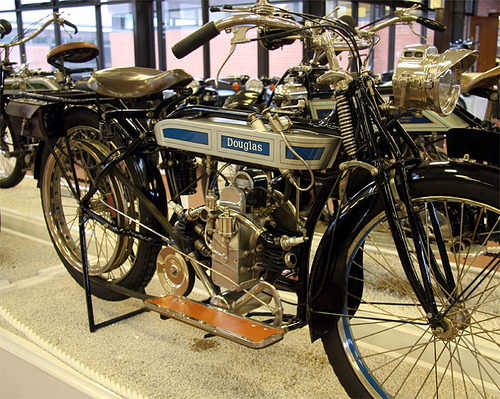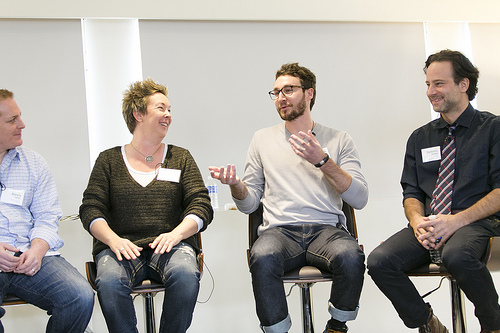Verify out these item development organization photos:
Douglas Motorcycles (Bristol) Timeline

Image by brizzle born and bred
In 1882, William Douglas and his brother Edward Douglas founded the Douglas Engineering Company, very first as a blacksmith’s shop, but quickly expanded to turn into an iron founders creating top quality castings, and later supplied components to Joseph Barter, of Light Motors, for his Fairy engine. After the turn of the century and the advent of the motor vehicle they quickly became involved in the development of engines.
•1885 Organization founded.
•1907 The initial model was introduced at the Stanley Show. Mounted higher in the frame, it had a two.75hp flat-twin engine with braced forks and direct-belt drive. They also exhibited a compact V4 engine, but only two or three of these were produced as the style was as well advanced for the occasions.
•1909-1912 New frame design and style brought alterations. A two-speed gearbox became accessible and a ladies’ model was developed. Douglas began supplying Williamson with 8h p flat-twin engines for their machines. They also had their very first achievement at the TT, with a win in the Junior class.
•World War I. Many models had been used by the forces and roughly 25,000 of these dependable machines went for service use. After the end of the war surplus bikes flooded the civilian marketplace till around 1920.
•1920 The W20 model, with its 2 cylinder, 348cc sv engine, was equipped with clutch, kick starter and 3-speed gear. It has a quite a handful of accessories, such as handlebar mounted watch, speedometer, full Lucas acetylene lighting, leather knee pads, protective shield under crankcase, holder for spare spark plugs and round leather case for spare tube or belt.
•1920s For the duration of the decade, Douglas had a Royal Warrant for supplying motorcycles to Prince Albert (late King George VI) and Prince Henry. Even King George V acquired a Douglas machine in this period.
•1921 The 3.5hp model was dropped and pivot-forked rear suspension produced a brief appearance. This was followed by the introduction of two models with ohv engines.
•1923-1925 The firm did nicely in the TT and proved that their motorcycles have been very good performers in several classes. In the course of this period Cyril Pullin became Chief Designer for Douglas.
•1926 An ‘all-new model’ was launched as the EW – created to appeal to these who demanded functionality with out a high price tag.
•1927 By now there had been five versions of the EW, and despite the fact that a serious fire broken the operates, Douglas saw good results in Australian dirt-track racing, as the low-slung style was properly suited to the terrain.
•1928 Cyril Pullin left the firm, to be replace by Freddie Dixon, who developed a racing TT model. It was later joined by a dirt-track model developed particularly for speedway.
•1931 The firm had turn out to be a public company and it was sold by the family.
•1932 New models have been added, but the firm was quickly in monetary difficulty.
•1934 They created a 494cc shaft-drive model called the Endeavour. William Douglas, by now very elderly, purchased back the faltering business and created a smaller range till the finish of the decade.
•1935 They were in economic trouble and had been taken more than by BAC.
•1935 Public business named as Aero Engines Ltd.
•1939-1945 Throughout the war, Douglas produced other products.
•1946 Name changed.
•1947-1950 Douglas launched a variety of new models. In 1948, Douglas was once again in economic distress and forced to rationalize its line to a series primarily based on a 350cc flat twin.
•1951 A 500cc prototype was shown, but in no way made. An agreement was produced for the organization to construct the Italian Vespa scooter beneath licence.
•1955 The final model made was the sophisticated and novel 350cc Dragonfly. Distinctive looks and great handling could not hide the low leading speed (75mph, despite the fact that a sports model claimed 84mph) and poor low-rev performance.
•1956 The firm was taken over by Westinghouse Brake and Signal Co.
•1957 The Vespa was still imported, but the finish of the Douglas was close.
•1961 Light engineers and metal founders, specialising in the manufacture of Vespa Motor Scooters, Road Brakes and Signal and Colliery Equipment. 2,000 workers.
•Note: For several years afterwards, nevertheless trading below the Douglas name, the organization imported Gilera mopeds and lightweight motorcycles.
Joseph Barter of Aston Gate, Bristol had been motorcycles produced from 1902 to 1905.
•1902-5 The machines have been developed by Joseph Barter. The engine had its drive pulley mounted on the camshaft so that, as it was larger than usual, belt slip was lowered. It was a primitive affair with the engine inclined above the frame downtube and only a few had been constructed. Joseph Barter then moved on to a flat-twin engine design, firstly referred to as Fée then Fairy, and the forerunner of the Douglas.
Fairy was a motorcycle produced from 1906 to 1907.
It was the anglicized name of the Fée, built by Joseph Barter of Bristol in 1905.
The machine had a two.5hp flat-twin engine fitted high in a stock bicycle frame, with transmission by chain to a counter-shaft and clutch, then by belt to the rear wheel.
In 1907, right after Joseph Barter had joined Douglas, the name was taken up by them.
Fée was a motorcycle developed in 1905 by Joseph Barter of Bristol.
Joseph Barter had first created a single-cylinder machine prior to this. He supplied it below his own name until, in 1905, he turned to a flat-twin engine. Later it was identified as the Fairy and was the fore-runner of the Douglas.
The Fée engine was two.5hp and mounted higher in the frame of a stock bicycle with braced forks. It had a massive flywheel on the left and the transmission was by chain to a countershaft. This carried a clutch and then went by belt to the rear wheel.
Within a year the name had been anglicized to Fairy.
•1905-05 Barter designed side-valve flat twins with 198cc / 346cc / 676cc engines. Also known as the Fairy.
Williamson Motor Co of Earlsdon, Coventry. Also as A. Williamson and Co.
•Company formed by William Williamson when he left the Rex Motor Manufacturing Co. Maker of vehicles from 1913 and motorcycles developed from 1912 to 1920.
•1912 The very first machine produced it debut and provided energy with silence, and no vibration, courtesy of its 8hp flat-twin water-cooled engine, made for them by Douglas of Bristol. As it was component of their stationary engine variety, it had a starting handle, like that of a auto. It was a common Douglas engine with side valves, gear-driven magneto and was installed low down in a extended frame to drive a two-speed Douglas gearbox with all-chain drive.
•1913 An air-cooled version was added, but it did not sell as nicely as the quieter machine and had a tendency to more than-heat. It did, nevertheless, continue to be provided as an choice. Most models sold have been water-cooled and used for sidecars.
•1916 Production continued until that year, and then stopped until right after the War.
•1919 Late in the year they returned with the air-cooled flat-twin and a new model with the 771cc sv JAP V-twin engine and three-speed Sturmey-Archer gearbox with all chain drive.
•1920 Only the V-twin remained, this being sold with the sidecar as a comprehensive combination. It was their final year of production.
Cyril George Pullin (1893-1965) was a British, inventor, engineer and motorcycle race driver born in Hammersmith.
In 1914 Pullin won the Isle of Man TT race. In the 1920’s he developed the Ascot vehicle and had a variety of helicopter engine patents.
In 1925 he developed the Powerwheel, a single cylinder rotary engine in the hub of a motorcycle wheel, including clutch and drum brakes. His sister was married to Stephen Leslie Bailey, a then prominent engineer at Douglas Motors, and several of his patents were filed under the name of that organization.
Brown and Roper was a motorcycle created in 1921.
This machine was the notion of two engineers named Messrs Brown and Roper of Salisbury, Wiltshire.
An attempt was produced to create a marketable single-track two-wheeler that was enclosed by an open car in order to supply weather protection. The basis was a 4hp sv flat-twin Douglas engine in a lengthened frame. This permitted the rider to be seated low down, in a space created amongst the existing saddle tube and the rear wheel.
Outrigger wheels have been carried on an auxiliary frame. A lever on the proper could be utilised to lower or raise these wheels, in order to maintain the machine upright when at rest. A wheel set right away in front of the rider and connected to the fork leading by tensioned lengthy rods, supplied the steering mechanism. It had a Douglas three-speed chain-cum-belt gearbox and transmission, and access to operating parts was simple. It is not believed that any machines other than the prototype have been ever built.
British Roadless was a motorcycle created in 1920.
This short-lived machine was an early experiment in tracked motorcycles. It propelled itself with a rubber V-belt that ran around the front and rear wheels. These were formed as pulleys with a series of miniature bogies on the reduce run. It was fitted with a 348cc Douglas flat-twin engine mounted above the rear wheel and was steered by turning the front wheel a little. As it lacked both grip and stability, it was not around for extended.
The British Aircraft Co was founded in 1928 to develop gliders
•1932 The founder C. H. Lowe Wylde fitted a Douglas 600cc engine to the BAC VII Tandam to produce the Planette.
•Two much more were constructed but on 13th Could 1833 Lowe Wylde was killed whilst demonstrating it.
•The company was acquired by Robert Kronfeld and renamed Kronfeld in 1936 but the organization closed in 1937.
Creative Product Group Panel | Encounter: Dev

Image by FreshTilledSoil
Constructing Your Creative Item Team, a panel session at Experience: Dev featuring 5 Founders, CTO’s, and Team Managers from digital agencies and solution companies across the US.
observed right here (from left to correct:)
Alexis Kopikis, Founder & CEO @ Krush
Tracey Halvorsen, President & Chief Visionary Officer @ Fastspot
Ethan Smith-Gillespie, President & Founder @ The System PDX
Dominic Bortolussi, Founder & CEO @ The Operating Group